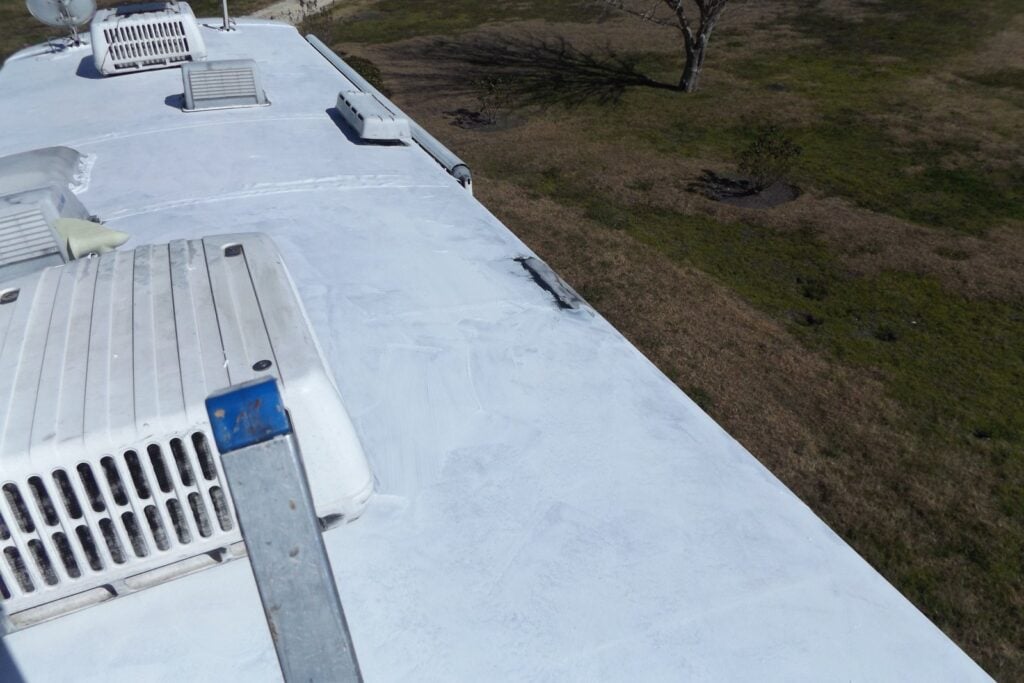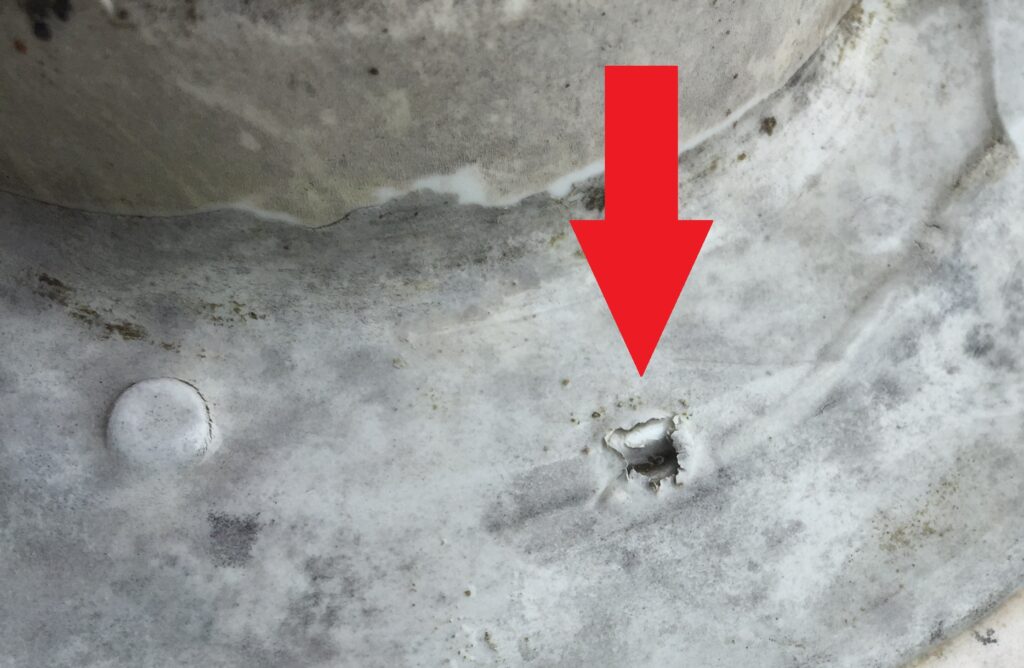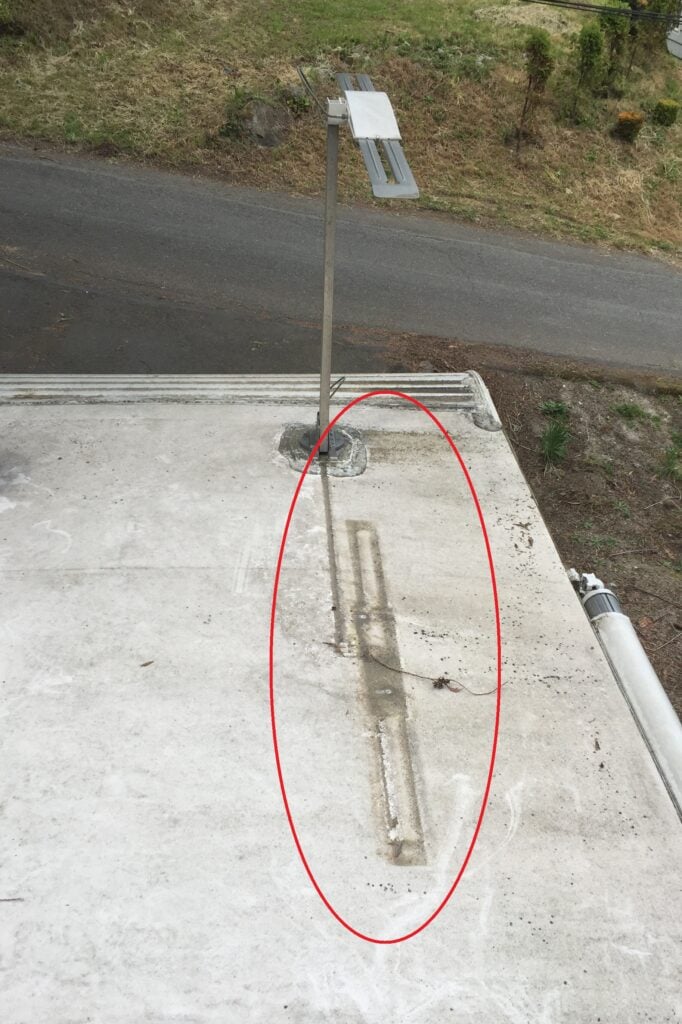Most RVers are familiar with the old adage “the best offense is a good defense” which is typically defined as proactively attacking one’s opponents or enemies being the best way to protect oneself (or their RV in this case).
When it comes to your RV’s roof, this means you should actively take a proactive stance in keeping your roof maintained against water intrusion, rather than possessing a passive attitude and doing nothing until you see signs of leakage in the interior of your RV. By the time you see water inside your RV, there is more work to be done than simply patching the leak.

Patch area. Photo via iRV2 member donnyman
How to inspect your RV roof
The simplest way to keep the rubber roof on your RV from leaking is by inspecting it several times a year.
Safety first: Getting up on your RV roof can present a fall hazard, so take appropriate steps to assure your safety in advance. If you don’t feel safe walking around on your RV’s roof, an RV service center might be a safer alternative to have the work done.
If there is a heavy accumulation of leaves or pine needles on your roof, start by sweeping it off or using a leaf blower. Next, wash the roof using a soft to medium bristle long-handled brush with a soft scrubbing motion to remove dirt and grime.
For tougher stains or areas with tight access, consider using a small hand brush or even a stiff-bristled toothbrush. If the RV has a crank-up TV antenna, raise it before washing so you can get underneath the portions that normally lay on the roof.
Only use cleaning chemicals that are free of petroleum distillates that could damage the rubber. Most car wash solutions are acceptable as is dish soap. While you are up there, be sure to clean your roof vents, solar panels, etc. with a soft rag.
Note: As you wash your roof, the dirt and grime will run down the side of your RV along with a chalky residue from the rubber roofing material, so be sure to hose down the walls of your RV before this combination has a chance to dry.

Definitely needs attention
Now that you have the roof of your RV clean, give it a good inspection, paying close attention to where the sealant has been applied to the rubber roofing around vents, antennae, side railings/seams, etc. Look for areas in the sealant that are cracked or lifting along the edge.
Many times cracks will show around screwheads that are anchoring the varying components, so look closely. While the rubber roofing material will seldom fail on its own, you will also want to inspect it for damage from tree limbs and abrasion.
One spot to look is where your crank-up TV antenna rests while in the down position.

Raise the TV antenna and clean underneath
Once you have identified potential places that water could enter, remove any loose sealant, thoroughly clean the area to be sealed (following the instructions on the new tube of sealant), and seal with the appropriate sealant available online or from your local RV dealer.
While you are on the roof, take the time to inspect all vent coverings (roof vents, refrigerator vents, skylights, and plumbing vents) for cracks and UV deterioration and replace them as needed.
Finally, to assure the integrity of the entire roof, check to make sure the bolts on the roof air conditioner(s) are properly tightened allowing the gasket to maintain the seal.
Conclusion
Remember, unlike a stick-and-bricks home, your RV is bouncing and twisting down the highway along with being exposed to varying amounts of UV rays and pollutants, so maintenance is required more frequently.
By regularly inspecting your RV roof and doing the required maintenance you can maintain a good offense and avoid an unexpected surprise, as a roof leak is an adventure in RVing none of us want to experience.
Make sure you keep track of all your RV maintenance and repairs with an online tool such as RV LIFE Maintenance. Not only can you keep all of your documents in one place, but you’ll also receive timely reminders when maintenance is due to help you avoid costly repairs and potentially serious accidents.

How long can I wait before recoating a roof on a new travel trailer?
I suppose you could wait forever. I recoat mine every year at the end of the summer/beginning of fall just to be safe. One thin tack layer then 2 heavier. Probably overkill, but I’d rather have too much instead of not enough
Why is it that all the articles I ever see deal with rubber roofs? There is very little about fiberglass roofs.
Since my roof antenna was designed for an analog TV, is it better to remove it since all the TVs are now digital? Does the radio use the roof antenna or is there a separate antenna for it?
The antenna on my 1985 Holiday Rambler still picks up digital signals just fine.
The antenna is also a digital TV antenna, the radio has it own antenna.
Never, never, never use dish soap on anything car or rv related unless you plan on striping the wax off the vehicle. Use only properly approved roof cleaning products and then rince the unit completely.
what sealent should i use on my 2006 H R roof?
I’ve had good luck using the white solar-flex elastomeric from Henry.
Spic & Span mixed according to the recommended ratio of it & water works fine for rubber roofs. Use of a long handled soft, or medium bristled brush. Do not go with a stiff bristle thinking you will not have to hard scrub as much. You will end up ruining your roof eventually just from using it.
What is a good roof sealant for a 1997 Prowler 5th wheel?
After I have had a leak, how do I clean the inside ceiling stain which is outlined with a darker water line?
Following this information provided in this context.will save you hundreds of dollars.you must regularly through out the year follow these simple maintenance details
Thoughts on EternaBond taping seals?
First make sure all the caulking is good. Then tape away. I never had a single leak on the seams I taped. It looks nice too.
It seems RV roofs must have a load limit. How heavy of a person can walk up the aluminum ladder and not crack the metal seams of the roof? –I would think using a tall ladder all around the RV would be much better than risking even more damage.